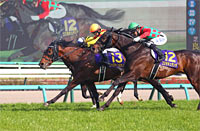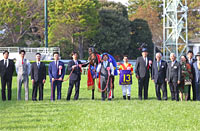2016 News
Data Analysis for the Satsuki Sho (Japanese 2,000 Guineas)Beginning of the classic Triple Crown races The Satsuki Sho, held at Nakayama Racecourse, is the first leg of the colts’ classic Triple Crown. After high-level finishes in each of the trials, a good contest is expected when the main event gets underway. With a glittering lineup once more assured, let’s check trends in this race based on data from the last 10 years (including 2011, when it was held at Tokyo Racecourse). Watch out for dark horses Viewing performances by win odds over the last 10 years, 5 horses have been backed by odds of “2.9 or less” in that time, but they have only produced one winner and a solitary runner-up. By contrast, horses with odds of “3.0-4.9” have achieved very impressive results, including a Top 3 ratio of 81.8%. Meanwhile, runners with odds of “10.0-19.9” are also putting in strong performances, including four wins, while those with odds of “30.0 or more,” though low in terms of success ratios, have produced three runners-up. As these data show, good performances by dark horses are by no means rare. [Table 1] [Table 1] Performance by win odds (last 10 years)
A strong performance last time out is key Turning next to performances by runners over the last 10 years by the finish in their previous race, horses with strong finishes in their most recent outing often produce good results in the Satsuki Sho. In fact, eight of the past 10 winners had also won last time out. Meanwhile, a statistic shared by the six Top 3 finishers that finished “2nd” last time out is that none of them had ever been beaten to 5th or lower since their debut. What’s more, three horses that recovered from a finish of “6th-9th” last time out to achieve a Top 3 finish here all had previously won in graded races. [Table 2] [Table 2] Performance by finish in previous race (last 10 years)
Also check the previous race itself Of the 30 Top 3 finishers over the last 10 years, 29 had most recently appeared in the Kyodo News Service Hai, Hochi Hai Yayoi Sho, Fuji TV Sho Spring Stakes, or Wakaba Stakes. The only notable performer coming straight from races other than these was Eishin Flash, which placed 3rd in 2010 (previous race was Keisei Hai, 1st place). [Table 3] [Table 3] Performance by previous race (last 10 years)
Check the distance of the maiden win and finish in the following race Over the last 10 years, runners with “a maiden victory over a distance of 1,800m or more and a Top 3 finish in the following race” have finished in the Top 2 every year except 2011, when the race was held at Tokyo Racecourse. Another point worth mentioning is that all of the horses in this category except 2012 winner Gold Ship had competed at one of the four major JRA racecourses (Nakayama, Tokyo, Kyoto, Hanshin) in the race immediately after their maiden win. [Table 4] [Table 4] Top 2 finishers with maiden wins over distances of 1,800m+ and a Top 3 finish in the following race (last 10 years)
Seek out the winner! The Satsuki Sho has been won for the last 3 years by horses with experience of “winning a race when starting in bracket No. 1 position.” If any of this year’s runners has experience of winning from the innermost bracket, it could well be worth a punt. [Table 5] [Table 5] Race won from the innermost bracket by the last 3 winners of the Satsuki Sho
(Yasunori Asano) |

|
|||||||||||||||||||||||||||||||||||||||||||||||||||||||||||||||||||||||||||||||||||||||||||||||||||||||||||||||||||||||||||||||||||||||||||||||||||||||||||||||||||||||||||||||||||||||||||||||||||||||||||||||||



















